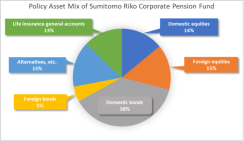This is the 6th Japanese asset owner interview to appear on II Innovation. The other 5 interviews are:
- Kewpie Pension Fund
- Chiba Bank Pension Fund
- West Japan Machinery (WJM) Pension Fund
- DIC Pension Fund
- Mitsui & Co. Group Pension Fund

There are notable challenges to investing in today’s market. High volatility can lead to unstable returns on equity investments, and the ultra-low interest rates – coupled with the risk that rates may rise to unknown heights in the future – produces low returns on bond investments. To address these challenges, we have adjusted the bias of return versus risk by assigning each fund a different role, such as “profit-seeking”, “risk-reducing”, or “responsive to interest rate rise”.
We are also positioned to invest in illiquid assets among alternatives, if necessary. However, given the difficulty of converting illiquid assets quickly into cash and the time required for cash flow management, we will exercise caution when considering such investments.

Management history: Colleagues at other funds serve as a valuable resource
After graduating from university, I joined Tokai Rubber Industries (now Sumitomo Riko Co., Ltd.). At the time, Tokai had the largest share of the automotive anti-vibration rubber market and I wanted to work for a company that produced unique and excellent products. I didn't like numbers and thought that accounting and finance were not for me, so I asked for a sales position. I was assigned to human resources instead, where my first job was recruiting and educating new graduates.After three years, I was assigned to the labor union in house, where my work centered mostly on labor management and health and safety of factory employees. From there, I was transferred to operations, then to an affiliate company, and then to the healthcare office where I understood nothing the company physicians said, so I studied for and obtained a health manager license.
In 2008, when I was assigned to the pension fund, I was really more interested in using my new license than tackling new tasks. However, I now feel asset management is the most interesting work I have ever done. I’ve learned a great deal about asset management by studying practices at other corporate pension funds and financial institutions, including at study sessions organized by other pension funds. I found other pension funds to be great allies and assets when I had few other resources to familiarize myself with the business. Asset managers use a lot of jargon and new concepts are constantly being introduced, most of which are difficult to understand. Reaching out to colleagues at other pension funds has been very helpful when there were scant resources to learn about the business. Now I feel it’s my turn to organize study sessions with financial institutions and share information with other pension funds.
Our daily work involves collecting information that we analyze and discuss with asset managers of financial institutions. In order to understand quarterly reports from the asset management companies, we have to pore over reams of materials, preparing a hearing sheet and formulating questions about the data. With over a dozen funds to evaluate, I have found it useful to examine how other funds evaluate their performance and, in the process – surprisingly – I overcame my aversion to numbers.
Learn more about Japan asset owners.




